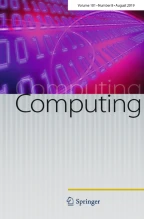Abstract
The probabilistic models for roundoff error in floating point and logarithmic arithmetic discussed in Barlow and Bareiss (1985) are applied to the error analysis of Gaussian elimination and some related algorithms. This new method of error analysis is compared to the standard deterministic error analysis given in Wilkinson (1963, 1965).
Zusammenfassung
Die von Barlow and Bareiss (1985) dargestellten stochastischen Modelle für den Rundungsfehler von Gleitkomma- und logarithmischer Arithmetik werden auf die Fehleranalyse des Gaußschen Eliminationsverfahrens und einiger verwandter Algorithmen angewendet. Diese neue Methode der Fehleranalyse und der von Wilkinson (1963, 1965) gegebenen deterministischen Standard-Fehleranalyse gegenübergestellt.
Similar content being viewed by others
Explore related subjects
Discover the latest articles, news and stories from top researchers in related subjects.References
Bareiss, E. H., Grau, A. A.: Basics of the CRD computer. Northwestern University ERDA Report COO-2280-35, Evanston, Illinois (August, 1977).
Barlow, J. L.: Probabilistic error analysis of floating point and CRD arthmetics. Ph. D. Thesis, Northwestern University, Evanston, Illinois (June 1981).
Barlow, J. L. Fast a posteriori bounds for roundoff error in Gaussian elimination. Technical Report No. CS-83-20, Department of Computer Science, The Pennsylvania State University, University Park, Pennsylvania (September 1983).
Barlow, J. L., Bareiss, E. H.: On roundoff error distributions in floating point and logarithmic arithmetic. Computing34, 325–347 (1985).
Barlow, J. L., Bareiss, E. H.: Probabilistic error analysis of Gaussian elimination in floating point and logarithmic arithmetic. Technical Report No. CS-84-21, Department of Computer Science, The Pennsylvania State University, University Park, Pennsylvania (December 1984).
Bustoz, J., Feldstein, A., Goodman, R., Linnaimaa, S.: Improved trailing digit estimates applied to optimal computer Arithmetic. JACM26, 716–730 (1979).
Clenshaw, C. W., Olver, F. W. J.: Beyond floating point. JACM31, 319–328 (1984).
Goodman, R., Feldstein, A.: Loss of significance in floating point subtraction and addition. IEEE Trans. on ComputersC-31 (4), 328–335 (1983).
Hogg, R. V., Craig, A. T.: Introduction to mathematical statistics, third edition. New York: Macmillan 1970.
Olver, F. W. J.: A new approach to error arthmetic. SIAM J. Num. Anal.15, 368–393 (1978).
Olver, F. W. J., Wilkinson, J. H.: A posteriori error bounds for Gaussian elimination. IMA J. Num. Anal.2, 377–406 (1982).
Reid, J. K.: A note on the stability of Gaussian elimination. JIMA8, 374–375 (1971).
Robertson, H. H.: The accuracy of error estimates for systems of linear algebraic equations. JIMA20, 409–414 (1977).
Von Neumann, J., Goldstine, H. H.: Numerical inversion of matrices of high order. Bulletin of the AMS53, No. 11, 1021–1099 (1947).
Wilkinson, J. H.: The Algebraic Eigenvalue Problem. Oxford: Clarendon Press 1965.
Wilkinson, J. H.: Rounding Errors in Algebraic Processes. Englewood Cliffs, N. J.: Prentice-Hall 1963.
Author information
Authors and Affiliations
Additional information
Work sponsored by the National Foundation under contract No. MCS-790150 and under contract No. MCS-8201065.
Rights and permissions
About this article
Cite this article
Barlow, J.L., Bareiss, E.H. Probabilistic error analysis of gaussian elimination in floating point and logarithmic arithmetic. Computing 34, 349–364 (1985). https://doi.org/10.1007/BF02251834
Received:
Revised:
Issue Date:
DOI: https://doi.org/10.1007/BF02251834
